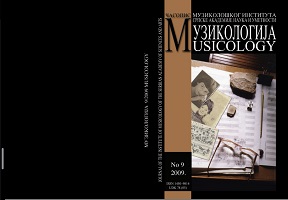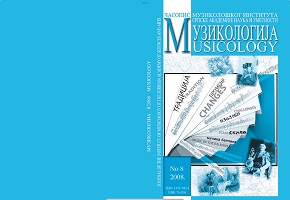
Комплементарност поетског и музичког система у обредним опходима домова
Analysis of poetic texts of the ritual – processions (koledari, lazarice, kraljice) in Southeastern Serbia has proved that poetical systems facilitate the differentiation at all levels of semantic relations connected to ritual practice: from denotatum (the current, real objects to which the individual ritual acts refers), specific designatum (mutual concept of given ritual, marked with existing denotata), to universal designata (general concept of all rituals, marked with specific designata and content denotata). However, with the frequent absence of indexic references (refrains, specific frames and lexemes), poetic texts have become universal in the denotation area of the general idea of fertility among all rituals, and the possibility of fragmentation/analysis and reality segmentation, which derive from the high communication potential of the verbal system, which contributes towards making key connections with denotata on the syntagmatic plan of the ritual process. In contrast with that, musical texts (as articulated entities or music “gestalts”) are always contextualized and ritually recognizable on a paradigmatic level. In this article the differentiation of poetic and music informative values are stressed: semantic (under which meaning, the presence of objects in the text as a sign, is considered) and numeric (which assigns a numerical quantity of innovation in the text). In a semantic sense, the musical message (in relation to the idea of the ritual) and poetic message (according to a concrete object and possibly the idea of the given ritual) are highly informative. In a numerical sense, again, the values of this message are different. The musical message, at the level of the initial model (starting pattern) holds a highly informative value relating to extramusical concept (designatum). However, its numerical informative value is rapidly reduced by model repetition in further melo-strophic appearances. A different principle is at stake when it comes to poetic structuralisation, in which a continuous flow of new verses (new content) produces increscent information. With such a mechanism, in a perceptual sense, the high redundancies of the musical model are being commutated. This redundancy of music content has the function of impacting and integrating it into individual and collective memory. The very thought of this parallel testifies to the frequently stressed differentiality of non-verbal and verbal communicational forms. During informational transfer “syntax of non-verbal ‘language’ has to be much simpler than the syntax of spoken or written language”. The combination of stated different principles is imminent to the performance of each song, and the total musical-poetical process of the ritual. The registration of a high number of texts and (almost) universal musical model for one ritual (at the same location) leads to key connections of the poetic system with specific objects – denotata – which ensure the syntagmatics of the ritual procession, and the connectivity of the music system with specific designatum marking the paradigm of the ritual. The different functions of these systems, their concretizations – music and poetic texts – complementarily and syncretically contributing to the efficiency of the ritual process, are noted. It is a matter of the different coding of the music and the poetic component, different informative aspects of their appearance, leading towards the creation of the integral ritual message. The high numerical information value of the poetic system originates from the highly symbolic value of natural language, precisely its great communicational potential, which carries discrete (continuous), conventional and arbitrary features. Those basic principles of symbolic representation of extralingual appearances, those kinds of reality segmentation, are the fundamental determinants of the poetic system. The fact that the function of the poetic system, based on stated characteristics, is unique and different from the determinant values of other ritual systems deserves special attention. In combination with the poetic system and its function of discretion, the musical system is perceived as simultaneous, integral and spatial, and because of that, functionally complemented. These features are assigned mainly to systems whose efficiency rests upon the possibility of temporal comprimation into one total perceptual experience. Whereas cognitive capacities are limited, this kind of complementarity, in which the musical system has limited numerical informative value, taking the role of main carrier of semantic information, leads to content implementation (determined by designatum) into the long-term memory, “in component of the systematic information processing in which our ‘total acknowledge of the world’ is permanently stored”. In accordance, the music system is analogous to other ritual systems in which the function of non-verbal, iconic relations are distinctive, and which are more suitable for the expression of ritual event totality. That connection of different types of ritual discourse is in direct connection with the explanation of ritual syncretism – as a unity of differences.
More...
